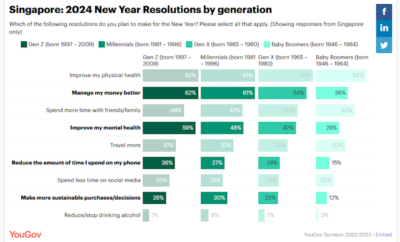
Insights + interviews
Understanding Your Sugar Addiction: In Conversation With Darren Blakeley
With the holiday treats and sweet drinks upon us this Christmas, we just had to know how much sugar we are taking in.
Because of its addictive nature, food manufacturers add sugar into pretty much everything as sugar plays on the reward centers of the brain to create the same highs and withdrawals as illegal drugs. We spoke with UFIT’s Darren Blakeley (DB) to find out more about sugar and the effects it has on the human body.
AA: Is sugar addiction a real thing or is it just made up?
DB: According to the National Centre for Biotechnology Information in the U.S, a recent published study on mice showed an unequivocal increase in dopamine activity when sugar was introduced to their diet. This stimulated addiction-like behaviour in the test cases, This is not the first study to find this. Sugar is highly addictive and unfortunately is found in a lot of processed foods.
AA: What is the effect of sugar addiction on the brain?
DB: It works by stimulating the release of dopamine which is a feel-good hormone. The primary problem we face is the need to consume more and more sugar to get the same resulting feelings from the dopamine, and more sugar makes us put on more weight.
AA: How does a person know that they’re a sugar addict? What are the signs?
DB: Typically symptoms range from mild headaches that can only be relieved with sugar to a feeling of a very empty stomach to literally the ‘sugar shakes’ when your limbs start to quiver!
AA: How much sugar does the average person consume per day?
DB: A very popular website based in the U.S – Authority Nutrition, suggests that in America, the average male was consuming 19 teaspoons of sugar daily. The daily recommendation by the American Heart Association is nine, which means they are consuming 10 additional spoons of sugar! In Singapore consumption of sugary drinks is very high (think iced lemon tea and other sugary sodas), in addition to white rice and noodles, which are quickly converted to sugar by the human body, so all these are counted as sugar consumption.
AA: What are some of the dangers of consuming too much sugar that people may not know about?
DB: The obvious one is weight gain and all the associated health risks with obesity. There is also other evidence suggesting that sugar contributes to inflammation which is related to increased coronary risk.
AA: There are seemingly endless types of sugar, but can you give us the breakdowns of the major ones?
DB: Sucrose is simple sugar that is derived from sugar cane or beets and is found on tables in cafes or ‘added’ to processed foods. Fructose is the sugar in fruit and lactose the sugar in milk.
AA: Does our body digest these sugars differently?
DB: Essentially the human body will break all these different sugars down into simpler forms that can be easily digested and then used as energy. The time that it takes the body to break down these sugars means some sugars are classified differently from others (glycaemic index). It is widely believed that the longer it takes for a sugar to break down, the better that particular sugar is for us. This is due to the reaction of the pancreas in releasing insulin, a hormone in response to ingested sugars. Insulin will quickly help the body store excess sugar as fat and the faster a sugar is broken down, the more fat gets stored.
AA: Many diets advocate strictly limiting fruit. What is your take on that? Are all sugars created equally?
DB: If we use the glycaemic index as mentioned above, fructose is ranked relatively low. Most fruits have low GI’s with some exceptions (Dates are incredibly high). Generally I am not an advocate of excessively restricting the consumption of fruit, but I must warn you that juicing or blending fruits should be done with caution. A glass of orange juice may have three or four more oranges which is as much sugar as a bar of chocolate. The GI of oranges is relatively low (43 on a scale of 100) but the rapid ingestion of that much sugar will wreak havoc with your insulin and result in fat storage!
AA: What fruits are ‘the best’ and ‘the worst’ when it comes to sugar content?
DB: I’m actually hesitant to say any fruit is the worst! Fruit typically is very good for us and I will rather have people eating too much fruit than just about any other food, with the exception of vegetables!
AA: There is so much hidden sugar in food these days. Any items people might find particularly surprising that have hidden sugars?
DB: A classic example is low-fat dairy products. Food manufacturers extract fat and replace it with added sugar, we now know this is an error as we need fat in our diets. There is already sugar (lactose) in all dairy produce, and more is added in the form of sucrose or high fructose corn syrup, which effectively doubles the amount of sugar! Another great example are cereals. Touted as ‘healthy’ most of them have crazy amounts of sugar!
AA: Tips for curbing sugar addictions?
DB: There is really only one way, cut it out. Do all you can to avoid sodas and other forms of sugary beverages. Reduce your consumption of white rice, noodles, breads and stop snacking on sweet foods. Eat more healthy fatty foods that have been shown to aid with your satiety (how full you feel), such as avocado, nuts and salmon.
AA: Can we adapt our taste buds to crave less sugar and if so, how?
DB: Taste buds when living without sugar begin to prefer fatty tasting foods. The reality is that dopamine is an incredibly powerful hormone, so most people will always love the high sugar produces. The key is to manage it!
AA: What kind of improvements can people expect by limiting sugar?
DB: As human beings, our fuel system is primarily powered by fat, not carbohydrate (which essentially is sugar stored as glycogen). Unfortunately our energy system will prefer sugar if it is available. Prior to supermarkets, cold storage, shelf life of food products, the fast-food culture and many of the other modern developments of food, the availability of significant amounts of sugar in everyday diets was low. Modern diets see us consuming mass amounts of sugar. This has created a dependency, elevated blood-sugar concentrations and turned the average human to ‘carb-dependent’ rather than what we were intended to be which is ‘fat-adapted’. Removing this sugar will see multiple benefits to health but most importantly return people to a ‘fat-adapted’ status. The everyday energy roller coaster of highs and lows or artificially stimulated continuous highs will be gone. People will start to think clearer, become leaner, work more efficiently and most importantly, eat less!










